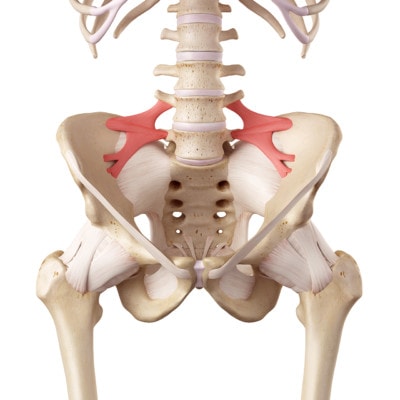Avoid Back Surgery by Learning More About the ACL of The Low Back: The Iliolumbar Ligament
Want to avoid back surgery? You may need to learn more about spinal stability and why the normal spine is an engineering marvel. Your spine depends heavily on two main systems to keep what amounts to a tower of kids blocks (vertebrae) aligned with millimeter precision as you move. To show you how this is done using muscles, I have blogged before on the longus colli in the neck and the multifidus in the low back.
But there’s another system as well, which prevents the blocks from moving too much when the muscles fail – the ligaments. To learn more about how all of this works, read our e-book, Orthopedics 2.0. Of the low back ligaments, arguably the most important ligament you’ve never heard of is called the iliolumbar ligament (ILL). It’s the ACL of the low back because it stabilizes the most mobile vertebra (the one at the bottom of the spine-L5). While all of the low back bones have ligaments to hold them together (think duct tape), usually only L5 (and sometimes L4) has an extra set of ligaments. This extra reinforcement reaches out from the transverse processes at the side of the vertebra and grabs onto the pelvis (see below). The ligament literally prevents the L5 vertebra from slipping forward, something it tends to do when you bend forward or if your low back has extra curve. In addition, if your muscular stability is trashed due to nerve problems at L5 or S1 causing your multifidus to atrophy, the ILL is extra important because it’s literally most of what keeps the L5 vertebra from slipping into your abdomen! Also note below that the ligament, when over stretched and painful, can refer pain into the front of the groin and low back, right along the dimples of Venus (see red areas below).
If this ligament is so important, why hasn’t anyone ever discussed it with you? Regrettably, for most physicians, the ligaments are literally invisible, despite their critical importance to spine stability. From a surgical standpoint low back fusions have been more commonly used to deal with instability rather than treating the ligaments. Above you’ll see an image that may be the first of it’s kind posted on the Internet-a fluoroscopic contrast picture of the ILL. This ligament can be injected in thinner patients using ultrasound, but in patients who are larger, fluoroscopy is needed to make sure you get the biologic directly in the ligament. Can you treat a degenerative disc that’s unstable and causing irritated nerves without surgery? The Regenexx-DDD procedure deals with both the lax ligaments and the irritated nerves without using harmful steroids. It can address a painful and lax ILL in addition to the multifidus atrophy caused by irritated nerves.
The upshot? If you have chronic low back pain and you want to avoid back surgery, your doctor should at least be considering the ILL as one possible cause of your problem!

Here, the iliolumbar ligaments are highlighted in red. SciePro/Shutterstock

NOTE: This blog post provides general information to help the reader better understand regenerative medicine, musculoskeletal health, and related subjects. All content provided in this blog, website, or any linked materials, including text, graphics, images, patient profiles, outcomes, and information, are not intended and should not be considered or used as a substitute for medical advice, diagnosis, or treatment. Please always consult with a professional and certified healthcare provider to discuss if a treatment is right for you.
